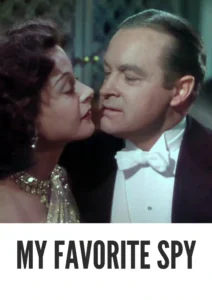Video Sources 0 Views
- Watch trailer
- My Favorite Spy 1951 Colorized


Synopsis
Table of Contents
Toggle
Step into a world of mistaken identities and uproarious comedy with My Favorite Spy, a side-splitting espionage caper from 1951, now beautifully colorized for a viewing experience that’s funnier and more vibrant than ever before. This film, starring the legendary Bob Hope alongside the glamorous Hedy Lamarr, delivers a delightful blend of slapstick, witty banter, and Cold War spoof within the exotic setting of Tangier. Perfect for fans of classic comedy, Bob Hope enthusiasts, and those looking for a lighthearted escape, this HD download brings a timeless piece of comedic brilliance to your screen. This comedic gem is also known under the titles: Passage to Cairo, Je moet maar pech hebben, Favori Ajanım, Favori Agentim, 挚爱侦探, 傻侠妖姬, 我的爱人是侦探, Spione, Liebe und die Feuerwehr, L’avventuriera di Tangeri, Στα Νύχια Των Κατασκόπων, Мой любимый шпион, A Cigana Me Enganou, Mi espía favorita, 我最中意的间谍, 마이 페이버릿 스파이, and Espionne de mon cœur.
My Favorite Spy follows the misadventures of Peanuts White (Bob Hope), a second-rate burlesque comic who bears an uncanny resemblance to international spy Eric Augustine (also Bob Hope). When Augustine is sidelined, U.S. intelligence agents recruit Peanuts to impersonate him on a dangerous mission to Tangier, Morocco, to acquire a top-secret microfilm worth a million dollars.
Arriving in Tangier, Peanuts is thrust into a world of intrigue, encountering the alluring Lily Dalbray (Hedy Lamarr), Augustine’s former “friend” who is now entangled with his arch-enemy, Karl Brubaker (Francis L. Sullivan). As Peanuts navigates through treacherous situations, dodging assassins in camel costumes and enduring truth serum injections that only make him recite old burlesque routines, he finds himself falling for Lily and questioning everyone’s true motives.
The real Eric Augustine makes a reappearance, further complicating matters and leading to a series of chaotic events. In a climactic chase scene involving a hijacked fire engine and Peanuts dangling from a hook-and-ladder, the microfilm ends up in the right hands, and Lily finds herself in Peanuts’. My Favorite Spy is a hilarious tale of mistaken identity, espionage, and unexpected romance that will leave you laughing from beginning to end.
The film boasts a stellar cast of comedic talents and Hollywood icons, including:
-
Bob Hope as Peanuts White / Eric Augustine
-
Hedy Lamarr as Lily Dalbray
-
Francis L. Sullivan as Karl Brubaker
-
Arnold Moss as Tasso
-
John Archer as Henderson
-
Luis van Rooten as Rudolf Hoenig
-
Stephen Chase as Donald Bailey
-
Morris Ankrum as Gen. Frazer
-
Angela Clarke as Gypsy Fortune Teller
-
Mike Mazurki as Monkara
-
Marc Lawrence as Ben Ali
My Favorite Spy is a delightful blend of comedy, spy spoof, and romantic caper, showcasing Bob Hope’s signature brand of humor and Hedy Lamarr’s captivating presence. Its lighthearted tone and slapstick antics make it a perfect choice for audiences of all ages.
Released in 1951, My Favorite Spy exemplifies Bob Hope’s enduring popularity as a comedic icon during the mid-20th century. The film cleverly spoofs the spy genre and reflects the anxieties of the Cold War era, using humor to diffuse tension and entertain audiences.
As the third installment in a loose trilogy featuring Bob Hope, including My Favorite Blonde (1942) and My Favorite Brunette (1947), My Favorite Spy solidifies Hope’s reputation for delivering laugh-out-loud comedies with a touch of adventure. The film’s success also highlights the appeal of pairing comedic actors with glamorous leading ladies, creating a dynamic that resonates with audiences.
This colorized version of My Favorite Spy has been meticulously restored, enhancing the visual appeal while preserving the film’s original comedic charm. The colorization process involved carefully analyzing the grayscale tones of the original black and white footage and assigning appropriate colors to each scene. This painstaking process breathes new life into the characters and settings, making the story even more engaging for modern audiences.
-
: Norman Z. McLeod
-
: Edmund L. Hartmann, Jack Sher, Hal Kanter, Lou Breslow, Edmund Beloin
-
: Paul Jones
-
: Victor Milner
-
: Frank Bracht
-
: Victor Young
-
: Paramount Pictures
-
: Paramount Pictures
-
: 93 minutes
-
: MP4
-
: HD (1080p)
-
: Compatible with most devices, including smartphones, tablets, computers, and smart TVs.
My Favorite Spy (1951) has garnered positive reviews for its comedic performances, witty writing, and entertaining plot. While some critics noted that Hedy Lamarr’s comedic timing may not be as sharp as other Bob Hope co-stars like Dorothy Lamour, her beauty and charm add to the film’s overall appeal. The film remains a beloved classic among Bob Hope fans and continues to entertain audiences with its timeless humor.
-
: What is My Favorite Spy about?
-
A: My Favorite Spy is a comedy about a burlesque comic who is recruited to impersonate an international spy in Tangier.
-
-
: Does Bob Hope play two roles in the movie?
-
A: Yes, Bob Hope plays both Peanuts White, the burlesque comic, and Eric Augustine, the international spy.
-
-
: Is My Favorite Spy (1951) part of a series?
-
A: Yes, My Favorite Spy is the third film in a loose trilogy featuring Bob Hope, along with My Favorite Blonde and My Favorite Brunette.
-
-
: Is this version of My Favorite Spy colorized?
-
A: Yes, this version has been professionally colorized to enhance the viewing experience.
-
-
: What is the download format?
-
A: The download format is MP4, which is compatible with most devices.
-
-
: What resolution is the download?
-
A: The resolution is HD (1080p), providing a high-quality viewing experience.
-
Get My Favorite Spy Now!












